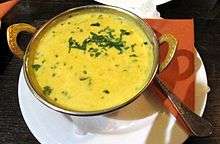Mulligatawny
 Mulligatawny soup as served in Mumbai | |
| Type | Soup |
|---|---|
| Place of origin | India |
| Serving temperature | Hot, often with rice |
| Similar dishes | Rasam |
Mulligatawny [ˈmɐlɨɡəˈtɑːni] (![]()
Recipes for mulligatawny varied greatly over the years, and there is no single original version. Later versions included British modifications that included meat,[1] though the local Madras recipe on which it was based did not.[2] Early references to it in English go back to 1784.[3] In 1827, William Kitchiner wrote that it had become fashionable in Britain:
Mullaga-Tawny signifies pepper water. The progress of inexperienced peripatetic Palaticians has lately been arrested by this outlandish word being pasted on the windows of our Coffee-Houses; it has, we believe, answered the "Restaurateurs' " purpose, and often excited John Bull, to walk in and taste—the more familiar name of Curry Soup—would, perhaps, not have had sufficient of the charms of novelty to seduce him from his much-loved Mock-Turtle.
It is a fashionable Soup and a great favourite with our East Indian friends, and we give the best receipt we could procure for it.[4][5]— The Cook’s Oracle; Containing Recipes for Plain Cookery on the Most Economical Plan for Private Families
By the mid 1800s, Wyvern, the pen-name of Arthur Robert Kenney-Herbert (1840–1916), wrote in his popular "Culinary Jottings" that "really well-made mulligatunny is ... a thing of the past."[2] He also noted that this simple recipe prepared by poorer natives of Madras as made by "Mootoosamy" was made by pounding:
a dessert-spoonful of tamarind, six red chillies, six cloves of garlic, a tea-spoonful of mustard seed, a salt-spoonful of fenugreek seed, twelve black peppercorns, a tea-spoonful of salt, and six leaves of karay-pauk. When worked to a paste, he adds a pint of water, and boils the mixture for a quarter of an hour. While this is going on, he cuts up two small onions, puts them into a chatty, and fries them in dessert-spoonful of ghee till they begin to turn brown, when he strains the pepper-water into the chatty, and cooks the mixture for five minutes, after which it is ready. The pepper-water is, of course, eaten with a large quantity of boiled rice, and is a meal in itself. The English, taking their ideas from this simple composition, added other condiments, with chicken, mutton, &c., thickened the liquid with flour and butter, and by degrees succeeded in concocting a soupe grasse of a decidedly acceptable kind.[2][6]
— Culinary Jottings
See also
- List of soups
- not to be confused with Mulligan stew (food)
References
| Wikimedia Commons has media related to Mulligatawny. |
- ↑ Dawe, W.H. (1888). The wife's help to Indian cookery : being a practical manual for housekeepers. London: Elliot Stock. p. 74.
- 1 2 3 "Wyvern" [Kenney-Herbert, Arthur Robert 1840-1916] (1885). Culinary Jottings. A treatise in thirty chapters on reformed cookery for Anglo-Indian rites, based upon modern English and continental principles with thirty menus (5 ed.). Madras: Higginbotham and Co. pp. 306–307.
- ↑ Yule, Henry (1902). Hobson Jobson (2 ed.). London: John Murray. p. 595.
- ↑ Kitchiner, William (1827). The Cook’s Oracle; Containing Recipes for Plain Cookery on the Most Economical Plan for Private Families. Edinburgh: Cadell and Co. pp. 262–263.
- ↑ Roy, Modhumita (2010). "Some Like It Hot: Class, Gender and Empire in the Making of Mulligatawny Soup". Economic and Political Weekly. 45 (32): 66–75.
- ↑ Procida, Mary (2003). "Feeding the Imperial Appetite Imperial Knowledge and Anglo-Indian Domesticity". Journal of Women's History. 15 (2): 123–149.